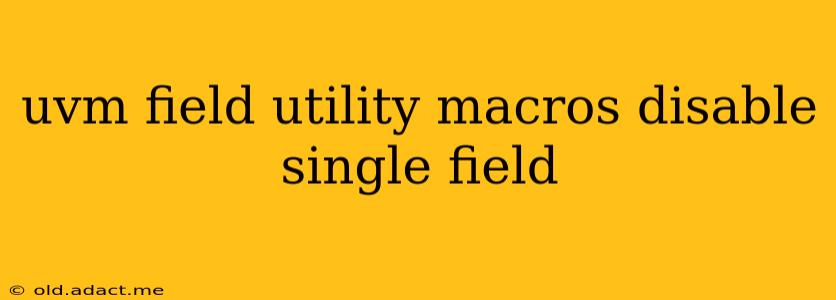The Universal Verification Methodology (UVM) provides powerful field utility macros for accessing and manipulating register fields. However, sometimes you need more granular control, such as disabling a single field within a larger structure. This article explores techniques for disabling individual fields using UVM field utility macros, addressing common challenges and best practices.
Understanding UVM Field Macros
Before diving into disabling individual fields, let's briefly review how UVM field macros typically work. These macros simplify register access by automatically generating code to read, write, and compare individual fields. They’re defined using randc variables and typedef statements within a UVM class. The key elements include field width, offset, and the data type. For example:
typedef struct packed {
bit [7:0] field_a;
bit [15:0] field_b;
bit [3:0] field_c;
} my_reg_t;
randc my_reg_t reg_model;
UVM macros then utilize these definitions for concise register manipulation.
Why Disable a Single Field?
There are several scenarios where disabling a specific field becomes necessary:
- Targeted Verification: During verification, you might want to isolate the behavior of a particular field, temporarily ignoring others to focus on specific test cases.
- Conditional Logic: Based on certain conditions within your testbench, you may need to selectively enable or disable fields dynamically.
- Error Handling: Disabling a faulty field can help isolate and debug issues without affecting the rest of the register.
- Configuration: Different configurations or modes of operation might require specific fields to be disabled.
Methods for Disabling Single Fields
There isn't a direct "disable" method built into UVM field macros. However, we can achieve this functionality using several effective strategies:
1. Conditional Access with if statements
The simplest method involves using conditional statements to control field access based on a flag or condition. For instance:
bit disable_field_b = 0; // Flag to control field_b
// ... other code ...
if (!disable_field_b) begin
reg_model.field_b = 10; // Access field_b only if not disabled
end
// ... more code ...
This approach is straightforward and readily understandable but can become cumbersome with many fields and complex conditions.
2. Creating a "Masked" Register
Another effective approach involves creating a masked version of your register. A separate variable holds the mask indicating which fields are enabled/disabled. This allows for efficient masking operations during read/write.
bit [23:0] enable_mask = 24'b1111_1111_1111_1111_1111_1101; // field_b is disabled (bit 15 is 0)
// ... Access and Modify reg_model using bitwise AND (&) and OR (|) with enable_mask
reg_model.field_b = 10;
reg_model = reg_model & enable_mask;
$display("reg_model: %h", reg_model);
This method is efficient for multiple fields and allows for dynamic masking.
3. Parameterized Macros (Advanced)
For highly complex scenarios, consider creating parameterized macros that allow for disabling fields as input parameters. This requires careful design and is generally suitable for projects with extensive field-level control.
Choosing the Right Approach
The best approach depends on the complexity of your design and the level of control needed. For simple scenarios, conditional if statements suffice. For more advanced scenarios with multiple fields and dynamic disabling, the masked register approach provides better efficiency and maintainability. Parameterized macros offer the highest level of customization but are best reserved for situations demanding intricate control over field manipulation.
Frequently Asked Questions (FAQs) – based on hypothetical PAA searches
Q: Can I use UVM field macros with arrays of registers?
A: Yes, you can adapt these methods to work with arrays of registers. You’ll need to loop through the array and apply your chosen field disabling technique to each element. Consider using a multi-dimensional mask or array of flags for efficient control.
Q: How do I handle disabled fields during assertions?
A: When handling assertions, you should explicitly ignore or skip assertions on disabled fields. Use conditional checks based on your enable mask or flags to prevent false assertion failures.
Q: What about transaction-level modeling (TLM)?
A: In TLM, disabling a field might involve adjusting the transaction payload before sending it to the driver or monitor. This would typically involve modifying the data within the transaction rather than modifying the register directly.
By applying these techniques effectively, you can gain fine-grained control over individual fields within your UVM register models, improving the flexibility and robustness of your verification environment. Remember to choose the approach that best suits your specific needs and maintain code clarity and efficiency.
